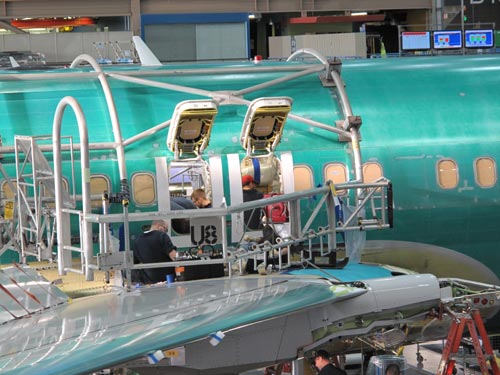Trade and Currency
Boeing's reach woven into China's aviation industry
By Li Xing (chinadaily.com.cn)
Updated: 2011-01-14 10:42
 |
Large Medium Small |
SEATTLE — David Langridge believes his job is taking him "around the world" without getting on board an airplane.
A driver with Boeing Commercial Airplanes, Langridge takes guests of the world's largest commercial aircraft manufacturer between their hotels and Boeing's sites in the suburban cities of Everett or Renton. There, the guests - pilots, mechanics, engineers and airline managers - work with Boeing staff to get their new aircraft inspected, receive training, improve their skills in aircraft maintenance or develop expertise in airport management.
Of his guests from around the world, many are Chinese.
"I feel like going around the world (with these guests)," Langridge said.
China is a frequent destination for Boeing's top commercial executives. Nicole Piasecki, Boeing commercial airplanes' vice president of business development and strategic integration, made her first visit to China in 1985 in an exchange program.
She remembered flying to Xi'an in an old Russian plane. The seats were not bolted down firm. "When we were taking off, our whole row went back," she recalled.
James F. Albaugh, executive vice president of the Boeing Company, has visited China three times since he also became president & CEO of Boeing Commercial Airplanes in September 2009.
"I'd like to think we (Boeing and China) are partners," Albaugh said in a recent exclusive interview with China Daily. "We worked with China to develop its aviation industry, aviation infrastructure, and we continue to depend on them as they, I hope, depend on us."
|
||||
There is the confidence in the growth of China market for Boeing's airplanes, despite competition from Airbus in Europe and China's effort to expand its high-speed railways and build its own regional and large aircraft.
"The prospects of China is very good," Albaugh said.
During his first visit to China, he was told that China needed to buy 200 airplanes a year. But Albaugh disagrees. "In my view, there is going to be a lot more than that, close to 300," he said.
Albaugh said he not only summed up the number of airports China was going to build, but also added "the size of the population, the percentage of the population that is likely to fly but hasn't flown yet, the percentage of the population that now wants to fly for leisure, travel, the number of tourists and business people that are coming to China from other countries".
In a word, "I think the opportunities are huge," Albaugh said.
 |
|
Engineers fix the safety gates for a Boeing 737. It takes about nine days to transport a Boeing 737 fuselage from a Boeing plant in Kansas to its final assembly plant in Renton, a small city near Seattle. [Li Xing/chinadaily.com.cn] |
Randy Tinseth, vice president of Marketing of Boeing Commercial Airplanes, had more numbers to show how China is "the market moving forward".
He told China Daily he based his analysis not only on China's present development but also on a 20-year forecast that his research team comes up every year since the 1950s, which "allows us to take a fresh look at the market and incorporate the latest thinking and analysis of the market".
Having gone through the economic cycles and business challenges over nearly six decades, Tinseth said air travel still managed to grow about 5 percent a year not only due to the strong link between air travel and the economy but also due to people's curiosities and their need to travel.
Since he visited China for the first time in the early 1990s, Tinseth has made more than 30 trips there, seeing the dramatic changes in skylines in Shanghai and experiencing "more complicated" driving on the road in Beijing.
"Putting yourself in a corner of Shanghai, you can feel the energy, with a certain smell. There is also a certain sound, like New York in similar ways, its business acumen, the banking, for instance," he said.
Today, Boeing has 31 customers in China flying about 870 Boeing airplanes. Moreover, Tinseth reckoned that about 190 million Chinese fly in Boeing airplanes. Two months ago, he announced in Beijing that his company forecasted that China would need 4,330 new commercial airplanes valued at $480 billion over the next 20 years.
In short, 20 years from now, more than 40 percent of all travel will begin and end within the Asia-Pacific market," Tinseth said, and China is about 40 percent of that demand. "This is our idea of the important role that Asia as well as China will play," he said.
By 2030, China's passenger traffic would reach 1.5 billion, Tinseth said, quoting from Boeing's 20-year forecast released recently.
"We cannot underestimate the power of tourism, both domestic and outside China. I know in the (drafted) 12th Five-Year Plan, tourism will be raised in terms of importance," he said.
Tinseth said he and his team are aware of China's ambitious plan to develop a high-speed rail system. Boeing sees it as both competition and complementing.
His research team examined the high-speed rail development plan. They concluded that high-speed rail would attract a lot more passenger flow between two cities within 800 km.
| 分享按钮 |


